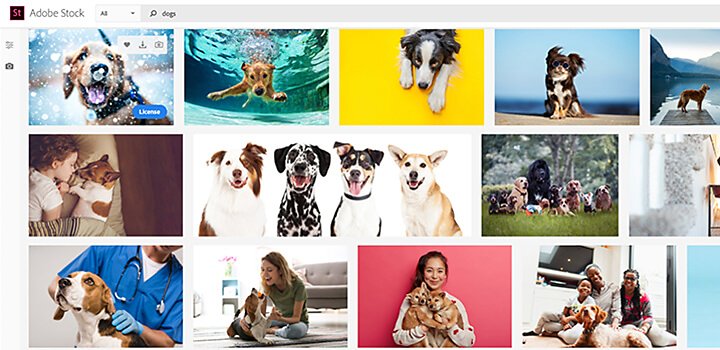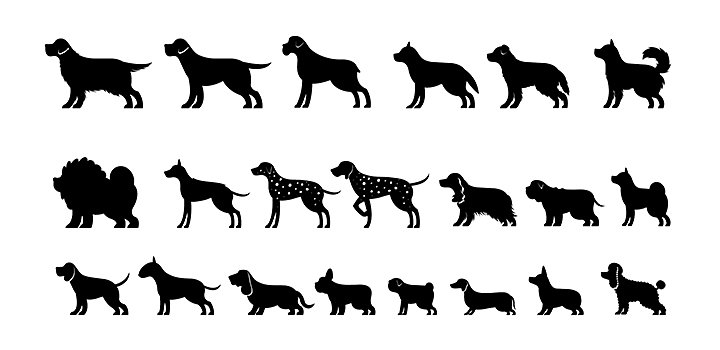How To Draw A Bunny How To Draw A Dog
Pup portraiture: How to draw dogs.
Whether yous're painting a realistic domestic dog or sketching a cute drawing puppy, option up some new tricks for capturing canine personality and emotion.
Best friends deserve close attention.
Dogs are ideal companions. They're often more attuned to our thoughts and feelings than we are, and they tell us a lot through their expressions and torso language. To describe a dog well, representing authentic anatomy and capturing their distinct personality, you have to examine them closely.
Study reference photos.
Earlier you follow any stride-by-step cartoon tutorials, determine the brood or combination of breeds you want to draw. A dachshund has quite different dimensions from a husky or gold retriever, and all of those accept completely unlike faces from a pug or Boston terrier. Study examples of the breed in photos, noting the distinctive characteristics. Cardinal differences tend to show upward in the following areas:
- Torso type: Large or small-scale, broad- or narrow-chested, long- or curt-legged
- Nose length and shape: Pronounced snout or smushy face, wide muzzle or narrow
- Ears: Upright or folded, large or small
- Fur length: Brusk or long; straight, wavy, or curly
- Fur color: Everything from solids to stripes to spots or combinations of all three

For useful reference photos of many types of dogs in every possible position, explore dog photos on Adobe Stock. If you're drawing a portrait of a specific dog, endeavor to observe equally many reference photos as yous can to become a sense of the dog's personality.
If you draw or paint digitally, you tin pull reference correct onto your canvas and fifty-fifty practice by tracing one or 2 digital dog photos. Bank check out this step-by-pace Adobe Photoshop Sketch tutorial to get started.
Understand dogs' bodies.
Your drawing can benefit from learning nigh canine muscular and skeletal structure. "Ane of the nigh helpful things when you're cartoon any kind of animal is to realize how their beefcake conforms with our own," says artist Jonathan Case. A domestic dog'due south skeleton is fairly similar to that of a human, with a spine connecting the head and cervix to a prominent rib cage and pelvis, simply the hips and neck are angled, and the proportions of the bones are different.
Dogs' legs can exist particularly difficult to capture. "What we think of as the dog's elbow is actually like their ankle, and their back legs have a very unlike structure from the forepart," creative person Megan Levens explains. "They're up on their toes similar virtually animals." Becoming familiar with the skeletal structure gives you a literal and figurative foundation to build upon. "Once you have an idea of how to balance that back pes and empathize where their thigh muscle sits in relation to their knee and their ankle, you get a better understanding of how to proportion them," says artist Lucas Elliott.
Begin your drawing with bones shapes.
Utilise simple shapes to create a rough outline of the dog'due south torso. Draw lightly — or, if yous're drawing digitally with Adobe Fresco, use a layer you lot'll hibernate later. "For a domestic dog with a longer snout, I'll depict a ball or a rounded cube for the master office of the domestic dog'southward head, the cranium, and and so I'll add together a cylinder, rectangle, or some sort of block for the rest of the snout," says Levens. "For shorter-faced dogs, it ends upwardly being two cubes kind of blocked together, or even one cube. And so a cylinder for the chest and a smaller rounded cube for the hip surface area."
For the legs, remember that the upper leg basic (femur and humerus) appear shorter than the lower leg basic. Check your sketch against reference photos and make adjustments until you're satisfied with the proportions.

Refine the silhouette.
Start turning those basic shapes into a dog's body by connecting and refining the outline. Over again, refer to your photos to judge whether the back is a straight line or slightly curved. Accommodate as necessary, especially when checking those tricky hind legs. If the domestic dog is fluffy, the outline may be softer, but don't forget about the muscle nether the fur. "You still have to know where the form is and how that dictates where the fur is going to grow," Levens says. "That's going to prove you where the musculature is."
Make full in the blanks.
Begin erasing your guidelines or hiding the outline layer if you're drawing digitally. Then add more than detail to the trunk contours, shading in the shadows that suggest muscles and fur variations. Note how the light hits the ears and nose, and don't forget the tail. For valuable tips on how to add color and texture to an adorable cartoon dog — and which brushes to use — watch this Adobe Live tutorial with illustrator and designer Natalie Murrow.
Source: https://www.adobe.com/creativecloud/illustration/discover/how-to-draw-dog.html
Posted by: conwaypubjer.blogspot.com


0 Response to "How To Draw A Bunny How To Draw A Dog"
Post a Comment